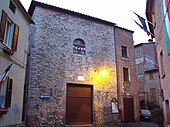Monteleone d'Orvieto
| Monteleone d'Orvieto | ||
|---|---|---|

|
|
|
| Country | Italy | |
| region | Umbria | |
| province | Terni (TR) | |
| Coordinates | 42 ° 55 ' N , 12 ° 3' E | |
| height | 500 m slm | |
| surface | 23.85 km² | |
| Residents | 1,380 (Dec. 31, 2019) | |
| Population density | 58 inhabitants / km² | |
| Post Code | 05017 | |
| prefix | 0763 | |
| ISTAT number | 055021 | |
| Popular name | Monteleonesi | |
| Patron saint | San Teodoro (June 29) | |
| Website | Monteleone d'Orvieto municipality | |
 Panorama of Monteleone d'Orvieto |
||
Monteleone d'Orvieto is an Italian commune with 1,380 inhabitants (as of December 31, 2019) in the province of Terni in the Umbria region .
geography
The community extends over around 24 km² . It is located about 35 km southwest of Perugia and about 60 km northwest of Terni . It is part of the administrative community Comunità montana Monte Peglia e Selva di Meana and is in the climatic classification of Italian communities in Zone E, 2 275GG. The place is on the rivers Chiani , Ripignolo and Fossalta. The Nestore rises in the northern municipality .
The districts include Colle, San Lorenzo, Santa Maria and Spiazzolino.
The neighboring municipalities are Città della Pieve ( PG ), Fabro , Montegabbione and Piegaro (PG).
history
The first human settlements in the place probably go back to the Etruscans . The history of today's town center begins in the 11th century with the construction of the castle, which was destroyed by Florence in 1643. The origin of the place name Montis Leonis is the Pope Leo IX. attributed, the addition of the name came from the direct influence of Orvieto , under whom the place was until 1373, when Charles IV. the castle subordinated to Count Turrena. After that, Count Ugolino di Montemarte da Corbara and the Counts from Marsciano ruled the place for a short time . 1398 subordinated Pope Boniface IX. Monteleone succeeded Count Francesco di Corbara , Bartolomeo Della Rovere , nephew of Pope Sixtus IV , as ruler before the place came under the control of Orvieto again in 1481. By marrying a bandini from Città della Pieve, the Countess Manfilia dei Conti di Montemarte da Corbara was able to register hereditary claims to the Castello, which resulted in a conflict with Orvieto, which could only be resolved on July 11, 1497 by the Peace of Monteleone and Orvieto Gained the upper hand over the place and began to strengthen the city walls. The Porta Nord city gate was also built at this time . In the first war for the Duchy of Castro , the place was first besieged in 1643 by troops from Florence as an ally of the Farnese against Urban VIII and captured a short time later. After the peace agreement of Castel Giorgio Monteleone was the Papal States to. The place was annexed by the Kingdom of Italy on September 9, 1860 and voted in favor of Victor Emmanuel II on November 9, 1860 , who declared Monteleone part of Umbria by decree on November 22.
Attractions
- Chiesa dei SS. Apostoli Pietro e Paolo , parish church . Contains works from the school of Perugino and the crypt of San Teodoro with relics of the same.
- Chiesa del SS. Crocifisso , church from 1637 just outside the city walls.
- Chiesa della SS. Annunziata , church with facade from 1770.
- Chiesa di San Cristoforo to 1706 incurred and on July 4, 1758 consecrated church in Colle Alto (hamlet Colle).
- Chiesa di Santa Maria Maddalena , church from the early 16th century in the district of Santa Maria.
- Porta Nord , the main gate of the city wall ring, was built in the Middle Ages and renovated in 1848. The Torra Mozza is located above the gate .
- Teatro dei Rustici , theater built in 1732, which with 96 seats is one of the smallest in the world.
- Torre dell'Orologio , clock tower in Piazza Bilancini from 1888, was originally planned as the town hall.
Sons and daughters of the church
- Pietro Bilancini (born September 21, 1864 in Monteleone d'Orvieto, † March 22, 1895 in Sassari ), poet and literary critic
- Attilio Parelli (born Attilio Enrico Paparella on May 31, 1874 in Monteleone d'Orvieto; † December 26, 1944 ibid.), Composer and conductor
Events
- Giostra del Giglio , also known as Palio del Giglio (Lily Palio), has been taking place on August 16 as a Palio since 1997 . It is the successor to the Palio del Carro (Wagenpalio), in which the districts faced each other between 1981 and 1996. Since 1997, only the two main historical fractions of the historic town center have been facing each other. This tradition goes back to the years between the 13th and 14th centuries, when the Guelphs of the Conti di Montemarte faced the Conti di Parrano , also called Conti di Marsciano or Bulgarelli . At that time the event was called Corteo storico di Monteleone d'Orvieto .
literature
- Touring Club Italiano : Umbria , Milan 1999, ISBN 88-365-2542-3 , p. 635.
Web links
Individual evidence
- ↑ Statistiche demografiche ISTAT. Monthly population statistics of the Istituto Nazionale di Statistica , as of December 31 of 2019.
- ↑ Website of the Agenzia nazionale per le nuove tecnologie, l'energia e lo sviluppo economico sostenibile (ENEA) (PDF; 330 kB), accessed on December 1, 2012 (Italian)
- ↑ Umbria website on the web, accessed on March 22, 2011 ( page no longer available , search in web archives ) Info: The link was automatically marked as defective. Please check the link according to the instructions and then remove this notice.




